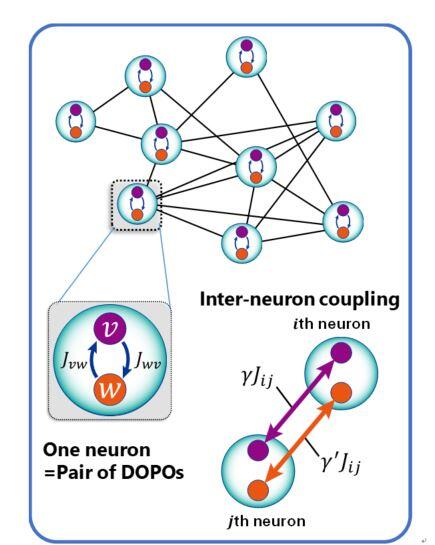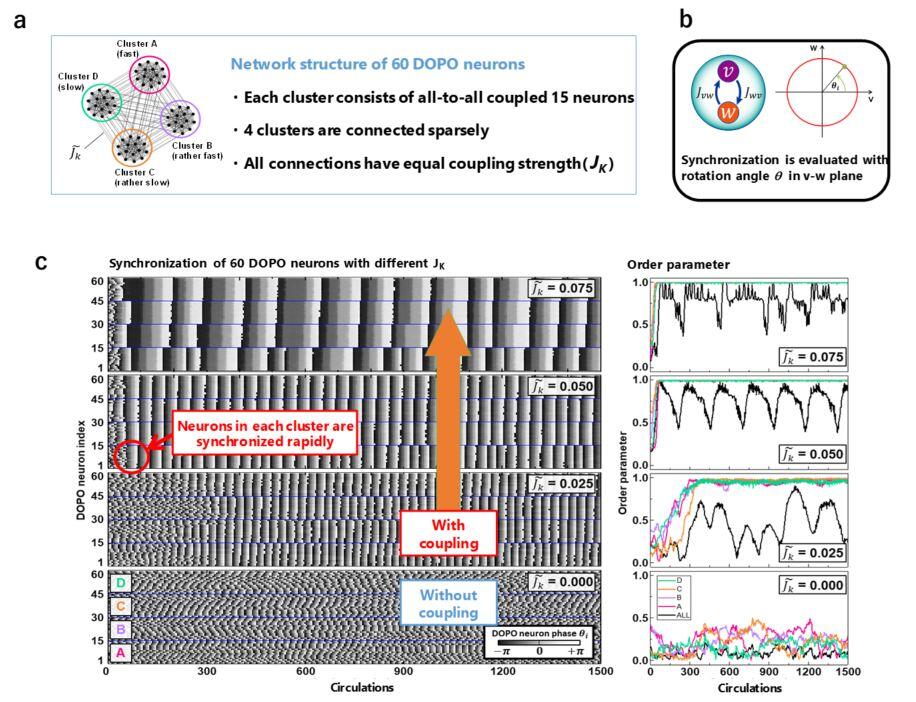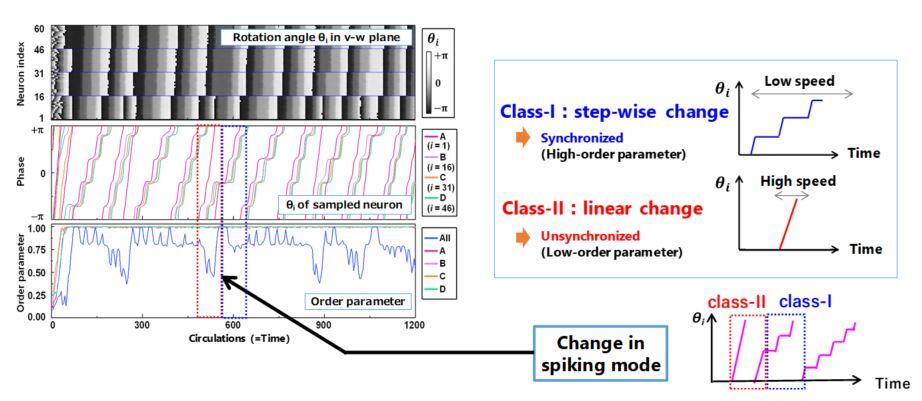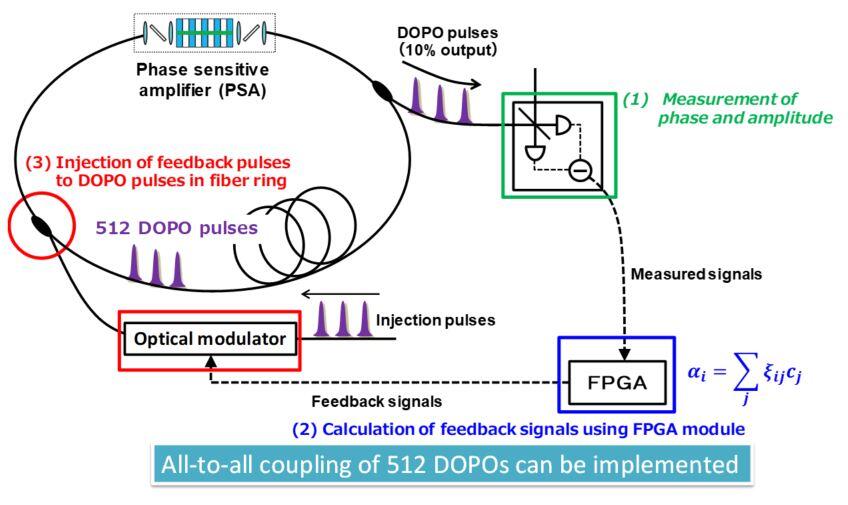Microsoft ends support for Internet Explorer on June 16, 2022.
We recommend using one of the browsers listed below.
- Microsoft Edge(Latest version)
- Mozilla Firefox(Latest version)
- Google Chrome(Latest version)
- Apple Safari(Latest version)
Please contact your browser provider for download and installation instructions.
April 23, 2021
Nippon Telegraph and Telephone Corporation
The University of Tokyo
Experimental realization of photonic spiking neural network
toward a new neuromorphic computing
Researchers at Nippon Telegraph and Telephone Corporation (headquartered in Chiyoda-ku, Tokyo; Jun Sawada, President & CEO; hereinafter referred to as "NTT") in collaboration with the group of University Professor Kazuyuki Aihara at The University of Tokyo (headquartered in Bunkyo-ku, Tokyo; Teruo Fujii, President) developed a photonic artificial neuron that emulates spiking signals*1 in biological neurons by using degenerate optical parametric oscillators (DOPOs)*2. A.L. Hodgkin*3 classified the spiking dynamics of neurons into two classes of spiking modes (Class-I and Class-II) on the basis of how spiking rates change as a function of external stimulus. This is called Hodgkin's classification. We demonstrated that both spiking modes can be created in the same setup and controlled arbitrarily by tuning the pump light that is injecting power to the system. The present neuron, called DOPO neuron, has high controllability of spiking modes, which will be advantageous for neuromorphic computation.
We further demonstrated that a network of 240 DOPO neurons exhibited a novel synchronization phenomenon*4, where DOPO neurons change their spiking modes spontaneously (without any parameter tuning) due to the synchronization of networked neurons. An interesting point is that neurons as a group can tune spiking modes dynamically and automatically, while a single DOPO neuron has no such controllability. The study of this collective and emergent property of DOPO neurons suggests that the spontaneous control of spiking frequency can constitute a key advantage in establishing new neuromorphic computing systems.
This work was published in the online-only journal Nature Communications on the 23rd April 2021 at 10:00 London time (GMT).
This research was funded by the Impulsing Paradigm Change through Disruptive Technologies (ImPACT) Program of the Council of Science, Technology and Innovation (Cabinet Office, Government of Japan).
1.Background
Information processing in the brain and biological systems is thought to be very efficient and high performance, even though the complete mechanism has not yet been well clarified. Pioneering studies have pointed out that neural information processing is based on spiking signals of neurons making it very different from information processing of the current standard computers (von Neumann type architectures). To clarify the mechanism of neural information processing, a spiking neural network (SNN)*5, which is an artificial neural network mimicking realistic neurons, has recently attracted much interest. In a SNN, it is important to consider the spiking signals as a point process and simulate the timing and frequency of spike firing, so it is necessary to develop application-specific devices and/or physical implementations.
Complex and diverse spiking dynamics has been experimentally studied with various nerve cells and analyzed numerically with various mathematical models. A pioneering researcher, A.L. Hodgkin, has demonstrated that the spiking dynamics can be simply classified into two spiking modes (Class-I and Class-II). This is called Hodgkin's classification of spiking modes. In various biological systems, various neurons have been categorized into these two classes of spiking modes. However, it is remained unclear how the two spiking modes are assigned to a role during neural information processing. It is therefore important to study SNN models by considering the diversity of spiking modes.
We developed an artificial photonic neuron by using degenerate optical parametric oscillators (DOPOs), and applied a nonlinear optical device and measurement feedback technique that have been established to construct a coherent Ising machine, which is a machine for solving combinatorial optimization problems. We used a nonlinear optical device developed in NTT to achieve controllability of spiking modes. A special experimental setup of measurement feedback is implemented for creating correlations between DOPOs to design a network of 240 DOPO neurons with arbitrary connections. As a result, we can develop a photonic neuron with high controllability of spiking modes and the ability to realize arbitrary network structures. Moreover, we observed a novel phenomenon accompanied with synchronization of networked neurons.
2.Results
A DOPO neuron is made from a pair of DOPO pulses as shown in Fig. 1, in which the two DOPOs are connected with opposite signs. The nonlinear effects in a phase-sensitive amplifier (PSA) play an important role to emulate spiking signals. The nonlinear device can be controlled by injecting a pump light and tuning its amplitude. We used this controllable nonlinearity in order to realize tunable spiking modes (see Fig. 2). For a weak pump light amplitude, we observed that spikes with high frequencies are induced by the external bias, and its spiking frequency hardly changes with the amplitude of external bias. This is a characteristic of the Class-II spiking mode within the Hodgkin's classification. For a strong pump amplitude, we observed that spiking frequencies gradually changed from small to large, characterizing the Class-I spiking mode. Without any external bias, we found that a spiking mode gradually changes from Class-II to Class-I with increasing pump light intensity. Note that this simple control with pump lights of spiking modes will be an advantage when applying it to neuromorphic computation.
We further demonstrated synchronization of DOPO neurons, which is an important concept in SNN systems. We found that spike firing becomes simultaneous when increasing interneuron coupling strength and evaluated an order parameter*6 that quantitatively characterizes the degree of synchronization. We further observed the following novel phenomenon caused by synchronization (see Fig. 4): A cluster of DOPO neurons changes its spiking modes spontaneously depending on the degree of synchronization. Note that a single DOPO neuron does not exhibit such a spontaneous change in spiking modes, while a group of them has such a function thanks to synchronization. Although spontaneous spiking-mode change is a natural phenomenon caused by synchronization, this "function" controls spiking frequencies to stabilize synchronization similarly to an algorithm on a computer. These findings suggest that a group of DOPO neurons can open the way for a new type of neuromorphic computing.
In summary, we developed a high-performance photonic artificial neuron by using DOPOs that can arbitrarily control spiking modes and a group of DOPO neurons can change spiking modes spontaneously. The present SNN system can realize arbitrarily network structures. This high controllability can be an advantage when applying DOPO neurons to neuromorphic information processing.
3.Technical points in detail
(1) Implementation of the DOPO neuron
As shown in Fig. 1, a DOPO neuron consists of two DOPO pulses connected to each other, where coupling strengths are set with opposite signs. Mathematical analyses clarified that this coupling creates a flow of energy between two DOPOs and is a key element of spiking dynamics. Another important element is nonlinearity of photons in a PSA.
(2) Network structure of DOPO neurons
As shown in Fig. 5, interneuron couplings were implemented using our measurement feedback technique, which is a hybrid scheme combining optical devices with electronic computing circuits. With this method, intra-neuron coupling (Jvw, Jwv) and inter-neuron coupling (Jij) can be easily controlled to arbitrary design network structures of up to 256 neurons. Figure 3(a) shows a network structure used in this study, in which four clusters are coupled with each other with sparse connections, and each cluster consists of 15 neurons and coupling inside a cluster is completely dense (complete graph). For each cluster, averaged spiking frequency was set to be a different value, suggesting that it was difficult to enable synchronization including all clusters. Interestingly, DOPO neurons controlled spiking modes spontaneously and changed spiking frequencies so that all clusters achieved synchronization even though each cluster had largely different spiking frequencies.
4.Outlook
Our DOPO neuron can control spiking modes by tuning injected pump light. By utilizing the property of DOPO neurons, we will attempt to build a new platform to investigate what role spiking modes play in biological information processing. We also observed a novel phenomenon caused by synchronization, namely, spontaneous controlling of spiking modes. By taking advantage of such cooperative and emerging features of DOPO neurons, we will investigate a new type of neuromorphic computation.
<Figures>
 Fig. 1. Schematic of DOPO neuron. Two DOPO pulses (called v- and w-DOPO) are connected, where coupling strengths Jvw and Jwv are set to opposite signs. Inter-neuron coupling between i-th and j-th neurons (Jij) is implemented by two channels (γ,γ'). Couplings Jij can be set for any i and j; thus, any network structure can be designed arbitrarily.
Fig. 1. Schematic of DOPO neuron. Two DOPO pulses (called v- and w-DOPO) are connected, where coupling strengths Jvw and Jwv are set to opposite signs. Inter-neuron coupling between i-th and j-th neurons (Jij) is implemented by two channels (γ,γ'). Couplings Jij can be set for any i and j; thus, any network structure can be designed arbitrarily.
 Fig. 2.Spiking signals of single DOPO. (a) Reaction against external bias increasing with time for weak pump amplitude. Spiking signals with high frequencies can be observed from certain time (bias), and spiking frequencies hardly change with time. These features are characteristics of Class-II spiking mode. (b) Same as (a) for strong pump amplitude. First, spiking signals with low frequencies appear, then frequencies become higher, which indicates Class-I spiking mode. (c) Change in spiking frequencies. (left) Frequency as function of external bias with fixed pump at weak pump amplitude. (center) Same as left panel at strong pump amplitude. (right) Frequency as function of pump amplitude without external bias, where spiking mode changes gradually from Class-II to Class-I.
Fig. 2.Spiking signals of single DOPO. (a) Reaction against external bias increasing with time for weak pump amplitude. Spiking signals with high frequencies can be observed from certain time (bias), and spiking frequencies hardly change with time. These features are characteristics of Class-II spiking mode. (b) Same as (a) for strong pump amplitude. First, spiking signals with low frequencies appear, then frequencies become higher, which indicates Class-I spiking mode. (c) Change in spiking frequencies. (left) Frequency as function of external bias with fixed pump at weak pump amplitude. (center) Same as left panel at strong pump amplitude. (right) Frequency as function of pump amplitude without external bias, where spiking mode changes gradually from Class-II to Class-I.
 Fig. 3.Synchronization experiments for 60 DOPO neurons. (a) Network structures used in study. (b) Definition of θ, rotation angle of neuron.(c) Dynamical change in θand order parameters in each cluster and all neurons. As coupling strength Jk increases, timing of spike firing synchronizes, which can be quantitatively confirmed from increases in order parameters. Synchronization inside clusters occurs with small Jk, while it seems to be difficult to synchronize in the entire network, which is due to different spiking frequencies of clusters. For most strong Jk (top panels), entire network order parameter reaches maximum, suggesting synchronization of entire network.
Fig. 3.Synchronization experiments for 60 DOPO neurons. (a) Network structures used in study. (b) Definition of θ, rotation angle of neuron.(c) Dynamical change in θand order parameters in each cluster and all neurons. As coupling strength Jk increases, timing of spike firing synchronizes, which can be quantitatively confirmed from increases in order parameters. Synchronization inside clusters occurs with small Jk, while it seems to be difficult to synchronize in the entire network, which is due to different spiking frequencies of clusters. For most strong Jk (top panels), entire network order parameter reaches maximum, suggesting synchronization of entire network.
 Fig. 4. Spontaneous change in spiking modes. Data were extracted from Fig. 3 except for the center-left panel, which shows dynamical change in θ for specific neuron in each cluster. As illustrated in right panel, the center-left panel clearly shows dynamical changes in spiking modes as follows. Before synchronization, linearly-increasing dynamics are characteristics of Class-II. After synchronization, dynamics changes to stepwise, suggesting mode change from Class-II to Class-I. At the proximity of area surrounded with red and blue boxes, Class-I mode changes again to Class-II, where entire-network order parameter increases rapidly. These findings suggest that group of DOPO neurons changes their spiking modes and spiking frequencies to stabilize synchronization.
Fig. 4. Spontaneous change in spiking modes. Data were extracted from Fig. 3 except for the center-left panel, which shows dynamical change in θ for specific neuron in each cluster. As illustrated in right panel, the center-left panel clearly shows dynamical changes in spiking modes as follows. Before synchronization, linearly-increasing dynamics are characteristics of Class-II. After synchronization, dynamics changes to stepwise, suggesting mode change from Class-II to Class-I. At the proximity of area surrounded with red and blue boxes, Class-I mode changes again to Class-II, where entire-network order parameter increases rapidly. These findings suggest that group of DOPO neurons changes their spiking modes and spiking frequencies to stabilize synchronization.
 Fig. 5. Experimental setup of DOPO spiking neural network. 512 DOPO pulses are generated using phase sensitive amplifier with periodically poled lithium-niobate (PPLN) waveguide in 1-km fiber ring cavity. All-to-all coupling of 512 DOPO pulses is implemented with measurement and feedback scheme.
Fig. 5. Experimental setup of DOPO spiking neural network. 512 DOPO pulses are generated using phase sensitive amplifier with periodically poled lithium-niobate (PPLN) waveguide in 1-km fiber ring cavity. All-to-all coupling of 512 DOPO pulses is implemented with measurement and feedback scheme.
<Glossary>
(*1)Spiking signal
In biological neurons, point-process like electronic signals with a steep peak structure have been observed, which is called spike. It has been pointed out that these signals transfer information in the brain processing.
(*2)Degenerate optical parametric oscillator (DOPO)
A DOPO pulse is generated by a phase-sensitive amplifier (PSA) with a nonlinear material in a cavity. Because degenerate parametric amplification is phase sensitive, the optical phase of each DOPO pulse takes only 0 or π.
(*3)Alan Lloyd Hodgkin
A pioneering researcher who studied biological system based on a mathematical approach and won a Nobel-Prize physiology or medicine at 1963 through collaborated research with Andrew Huxley. Hodgkin proposed that the reaction of realistic neurons can be classified into two classes of spiking modes.
(*4)Synchronization
A phenomenon induced by the inter-neuron couplings, where timing of spike firings of networked neurons becomes at the same time.
(*5)Spiking neural network
Artificial neural network that can mimic spiking signals of biological neurons.
(*6)Order parameter
Physical quantity characterizing synchronization. Large- (small-) order parameters indicate that synchronization (does not) occur.
<Paper publication information>
Title: Collective and synchronous dynamics of photonic spiking neurons
Authors: Takahiro Inagaki, Kensuke Inaba, Timothée Leleu, Toshimori Honjo, Takuya Ikuta,
Koji Enbutsu, Takeshi Umeki, Ryoichi Kasahara, Kazuyuki Aihara, and Hiroki Takesue
Journal: Nature Communications(23rd April 2021)
DOI: 10.1038/s41467-021-22576-4
Press inquiries regarding this matter
Nippon Telegraph and Telephone Corporation
Public Relations Department, Science and Core Technology Laboratory Group
science_coretech-pr-ml@hco.ntt.co.jp
℡ 046-240-5157
The University of Tokyo
University Professor/Emeritus Professor
Kazuyuki Aihara
E-mail: kaihara@g.ecc.u-tokyo.ac.jp
International Research Center for Neurointelligence
The University of Tokyo Institutes for Advanced Study
Public Relations
E-mail: press@ircn.jp
Information is current as of the date of issue of the individual press release.
Please be advised that information may be outdated after that point.
NTT STORY
WEB media that thinks about the future with NTT










